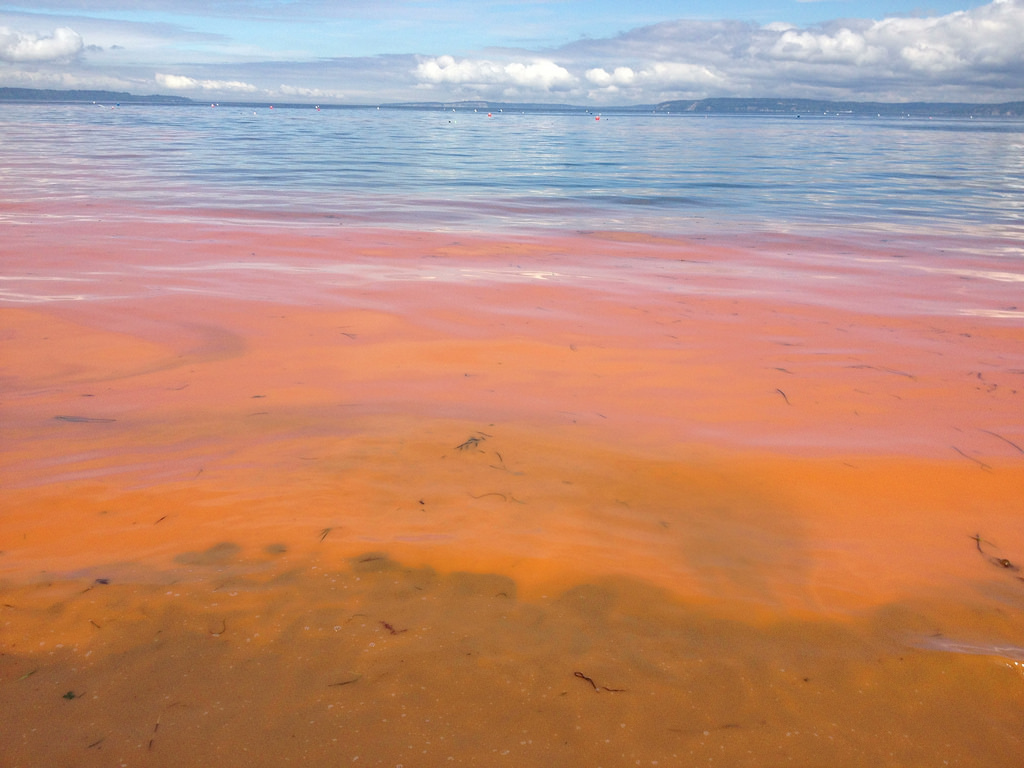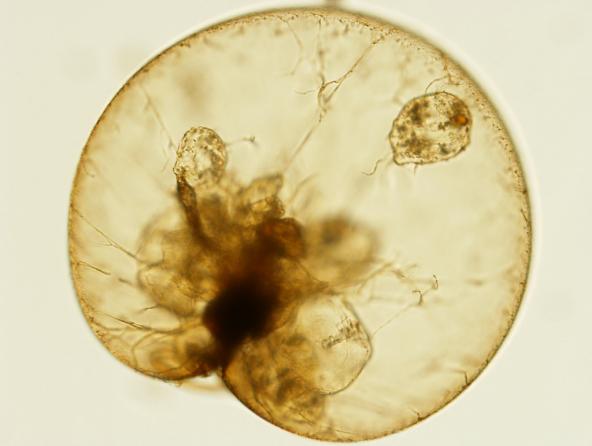
High amounts of elements such as nitrogen can cause blooms of phytoplankton that sometimes trigger perturbations throughout the food web. This occurs most often in the spring and summer after the long, dark, cloudy days of winter begin to fade.

The arrival of increased sunlight and warming waters stirs the plankton to grow and multiply more rapidly, as their chlorophyll collects energy from the sun.
Marine waters, churned up by winter storms, begin to stabilize, as rivers continue to deliver nitrogen-rich waters from the watersheds. Since rivers consist of freshwater, the incoming flows tend to float in a layer atop the heavier seawater in Puget Sound. Winds and currents mix the layers more slowly as spring moves into summer and river flows decline.
Sunlight, temperature, minerals, salinity and water circulation all are keys to the rate of plankton growth, often determining which types of plankton dominate in the Battle of the Species. Marine biologists are disinclined to label plankton as good or bad, yet some species help and others hinder an ecosystem that once supported an abundance of herring, salmon and killer whales, along with thousands of other species.
Spring phytoplankton growth is dominated by diatoms, a stunningly beautiful variety of planktonic species. Each microscopic diatom is encased in a cell wall made of silica, the raw material for glass. One might say that diatoms are algae that live in glass houses. Many are circular wheel-like creatures, while others are elongated.
Diatoms are considered a foundation of the food web, providing energy-rich lipids for a variety of zooplankton — from tiny shrimplike crustaceans, such as krill and copepods, to the larval stages of fish, crabs and shellfish. Nearly every predator becomes prey in a healthy food web, right up to orcas at the top.
The need for silica — a natural mineral brought down in river flows — can limit the growth of diatoms as spring turns to summer and river flows decline. Meanwhile, at the sewage-treatment plants, nitrogen continues to flow into Puget Sound at a steady rate right through the summer and fall.
Christopher Krembs, an ecologist in Ecology’s Environmental Assessment Program, has shown how diatoms become defeated by other phytoplankton, such as dinoflagellates, when concentrations of silica decline compared to available nitrogen. Dinoflagellates, which include a variety of toxic species, are characterized by tail-like flagella that help them move through the water.
A common dinoflagellate, Noctiluca scintillans, also known as the “sea sparkle,” produces no significant toxins, yet its extensive orange plankton blooms across Puget Sound are being viewed with growing concern.

Noctiluca, which are much larger than most dinoflagellates, will devour all sorts of plankton they encounter — from diatoms to copepods to fish eggs. They eat up plankton that would otherwise be available for other species.
“Noctiluca love to eat diatoms,” Krembs said. “They can graze down the entire phytoplankton biomass in a single day.”
Unfortunately, he said, Noctiluca are eaten by few other species, so they create something of a dead end in the marine food web.
Battle of the species
Researchers have learned a great deal about plankton growth in Puget Sound through the years, but they are still struggling to figure out what combination of nutrients and water conditions favor one type of plankton over another, according to Vera Trainer, manager of the Marine Biotoxins Program at NOAA’s Northwest Fisheries Science Center.
Spring diatom blooms give way to other phytoplankton, notably dinoflagellates, which can use their flagella to swim down into deeper water to find nitrogen then back to the surface for sunlight. The plankton that dominate are the ones best able to take advantage of the physical and chemical conditions of the moment.
Some species compete better in the presence of low or high levels of nitrogen or phosphorus, Trainer said, “but it’s not just the macronutrients; micronutrients like iron and copper are also important.”
Among the wide variety of dinoflagellates are several species known for their toxicity. Humans may be exposed by eating shellfish, which concentrate the toxins through filter-feeding. Alexandrium is responsible for paralytic shellfish poisoning, which can cause neurological problems, sometimes leading to death. Dinophysis is associated with diarrhetic shellfish poisoning, which can trigger severe vomiting and diarrhea. State and county health officials test shellfish regularly to protect people who eat shellfish.
Puget Sound is not alone in the increase of toxic plankton, which create harmful algal blooms. Just about every coastal country in the world has seen an expansion in the number of toxic species, often dominated by dinoflagellates, experts say.
Some species significantly increase their toxicity under certain conditions, Trainer said. Ongoing research to understand what triggers the increased toxicity might help control the problem.
Normally, shellfish thrive on high concentrations of plankton, but oysters have been known to succumb to high levels of paralytic shellfish poison, according to Gordon King, a shellfish manager for Taylor Shellfish Farms, one of the largest growers in North America.
For other plankton, shellfish may respond in surprising ways, such as in 2010 when mussels in Totten Inlet apparently stopped eating in the middle of a plankton bloom.
“The water was full of a brown algae,” King recalls. “You would think the mussels would be eating well, but they were starving to death.”
A high rate of mussel mortality in South Puget Sound that year was linked to the massive growth of the dinoflagellate Akashiwo sanguinea. These plankton do not produce a toxin, but mussels obviously don’t like them and may simply close up their shells and refuse to eat. The same phenomenon has been seen with oysters on occasion.
Akashiwo, which do not contain a normal cell wall, were linked to the deaths of thousands of sea birds off the coasts of Washington and Oregon in 2009. When the plankton die, their cells break apart, releasing a soaplike surfactant that becomes a floating foam. The substance can strip away the protective oils on birds’ feathers, making the birds vulnerable to hypothermia.
As with most plankton, it is not clear what conditions give rise to extensive blooms of Akashiwo. For dinoflagellates in general, a variety of studies suggest that higher water temperatures and increased ratios of nitrogen to other nutrients may be key factors.
“It does seem like we’re getting more and more dominant dinoflagellates that don’t suit my mussels very well,” King said.

Low oxygen
In late summer or early fall, oxygen levels often decline in some areas of Puget Sound, as the large biomass of dead plankton, produced during spring and summer, comes under attack by bacteria. Available oxygen is consumed by the bacteria as they break down the dead plankton.
The low-oxygen problem can be especially acute in long dead-end waterways, including Budd Inlet, Eld Inlet, Totten Inlet and Carr Inlet, all in South Puget Sound, as well as Lynch Cove at the end of Hood Canal, which is 68 miles long.
In low-oxygen conditions, fish will swim away if they can, while less mobile creatures will struggle to breathe and perhaps die. Animals living in low-oxygen conditions may undergo developmental, reproductive or immune-deficiency problems and may be susceptible to predation.
Slow water circulation and the layering effect, known as stratification, encourage the growth of plankton and the buildup of a low-oxygen layer, often at the bottom. Especially susceptible are protected bays and inlets with little or no freshwater inflow to stir up the water and infuse oxygen. South Puget Sound, which has many of these little inlets, is second only to Hood Canal in having the longest flushing period in the region.
The fluffy white bacterial mats observed in Hood Canal have been spotted in other areas during low-oxygen conditions, which can be deadly to some species. When plankton-eating animals are wiped out, the result is an even greater buildup of organic material, according to Matt Lonsdale, who was a student at the University of Puget Sound in 2006 and ‘07 when he first investigated the Hood Canal bacterial mats from a boat.
“You get a buildup of all that stuff falling through the water column,” he said, adding that he watched as startling images were picked up by a remote video camera. “If you’ve ever driven through a snowstorm with bright lights reflecting back from the snowflakes, you know what it was like.”
Beggiatoa require at least some oxygen to survive, so they form fluffy loops to maximize their oxygen uptake, said Lonsdale, now a teacher at Tacoma School District’s Science and Math Institute. They also thrive on the hydrogen sulfide produced by other bacteria that live in the sediments and break down organic wastes.
Beggiatoa are not as rare as researchers once thought. They are known to live on the wood wastes at the bottom of Tacoma’s Commencement Bay and in other places. Gordon King of Taylor Shellfish has seen the white mats while scuba diving around his mussel rafts in Totten Inlet and other areas of South Puget Sound.
Bacterial mats will grow and shrink with changing conditions, but they are not associated with a healthy underwater ecosystem, said Lonsdale. “It’s an alien place down there.”



